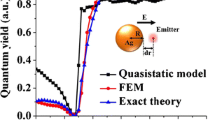Abstract
A mathematical model of fluorescence enhancement in the presence of a plasmonic structure is examined by applying a modified discrete source method that takes into account the nonlocal interaction between the elements of the plasmonic structure. The fluorescence quantum yield is computed using a generalization of the optical theorem to the case of a local excitation source. The elements of the plasmonic structure are optimized in order to maximize the fluorescence enhancement factor.
Similar content being viewed by others
References
N. Sui, L. Wang, T. Yan, et al., “Selective and sensitive biosensors based on metal-enhanced fluorescence,” Sen. Actuators 202, 1148–1153 (2014).
T. Zhang, G. Lu, W. Li, et al., “Optimally designed nanoshell and matryoshka-nanoshell as a plasmonicenhanced fluorescence probe,” J. Phys. Chem. C 116, 8804–8812 (2012).
L. Novotny and N. van Hulst, “Antennas for light (review article),” Nature Photonics 5, 83–90 (2011).
J-W. Liaw, H.-C. Chen, and M.-K. Kuo, “Comparison of Au and Ag nanoshells’ metal-enhanced fluorescence,” J. Quant. Spectrosc. Radiat. Transfer 146, 321–330 (2014).
J-W. Liaw, H-C. Chen, and J-H. Chen, “Enhancement or quenching effect of metallic nanodimer on spontaneous emission,” J. Quant. Spectrosc. Radiat. Transfer 111, 454 (2010).
N. V. Grishina, Yu. A. Eremin, and A. G. Sveshnikov, “Analysis of plasmon resonances of closely located particles by the discrete sources method,” Opt. Spectrosc. 113 (4), 440–445 (2012).
M. I. Mishchenko, “The electromagnetic optical theorem revisited,” J. Quant. Spectrosc. Radiat. Transfer 101, 404–410 (2006).
D. Colton and R. Kress, Integral Equation Methods in Scattering Theory (Wiley, New York, 1984; Mir, Moscow, 1987).
Ch. Hafner, “Boundary methods for optical nano structures,” J. Phys. Stat. Sol. B 244, 3435–3447 (2007).
Yu. A. Eremin and A. G. Sveshnikov, “Mathematical models in nanooptics and biophotonics based on the discrete sources method,” Comput. Math. Math. Phys. 47 (2), 262–279 (2007).
N. V. Grishina, Yu. A. Eremin, and A. G. Sveshnikov, “Analysis of double surface plasmon resonance by the discrete source method,” Comput. Math. Math. Phys. 54 (8), 1251–1260 (2014).
Author information
Authors and Affiliations
Corresponding author
Additional information
Original Russian Text © N.V. Grishina, Yu.A. Eremin, A.G. Sveshnikov, 2016, published in Zhurnal Vychislitel’noi Matematiki i Matematicheskoi Fiziki, 2016, Vol. 56, No. 1, pp. 133–141.
Rights and permissions
About this article
Cite this article
Grishina, N.V., Eremin, Y.A. & Sveshnikov, A.G. Discrete source method for analysis of fluorescence enhancement in the presence of plasmonic structures. Comput. Math. and Math. Phys. 56, 140–147 (2016). https://doi.org/10.1134/S0965542516010097
Received:
Published:
Issue Date:
DOI: https://doi.org/10.1134/S0965542516010097




